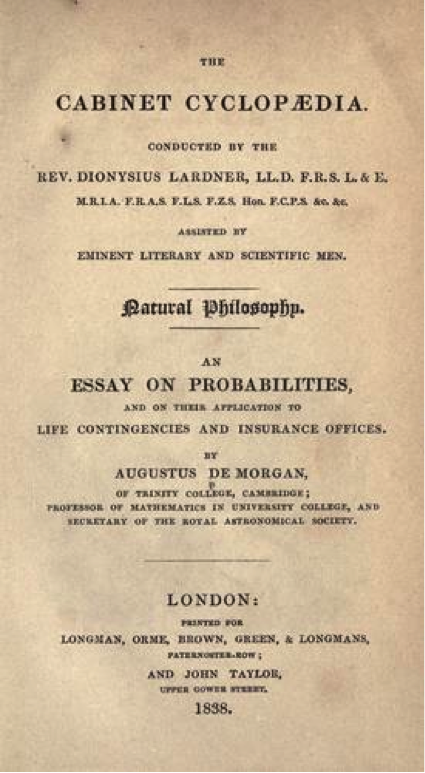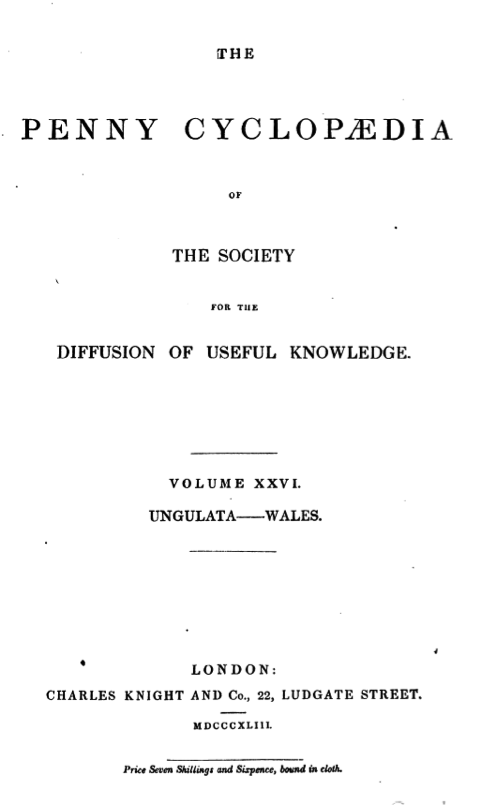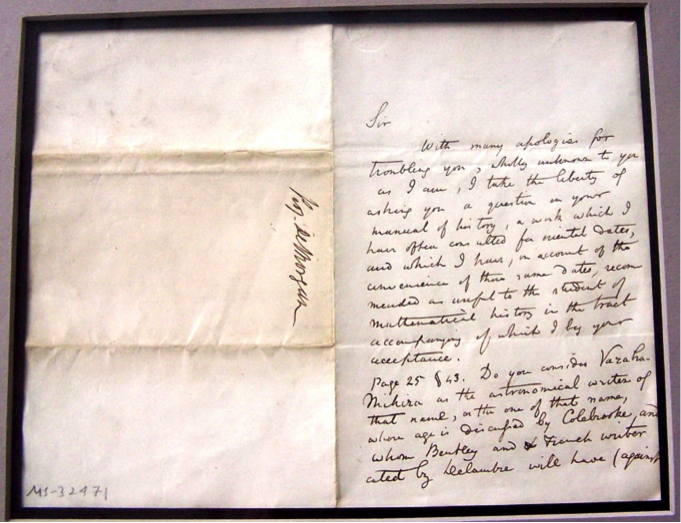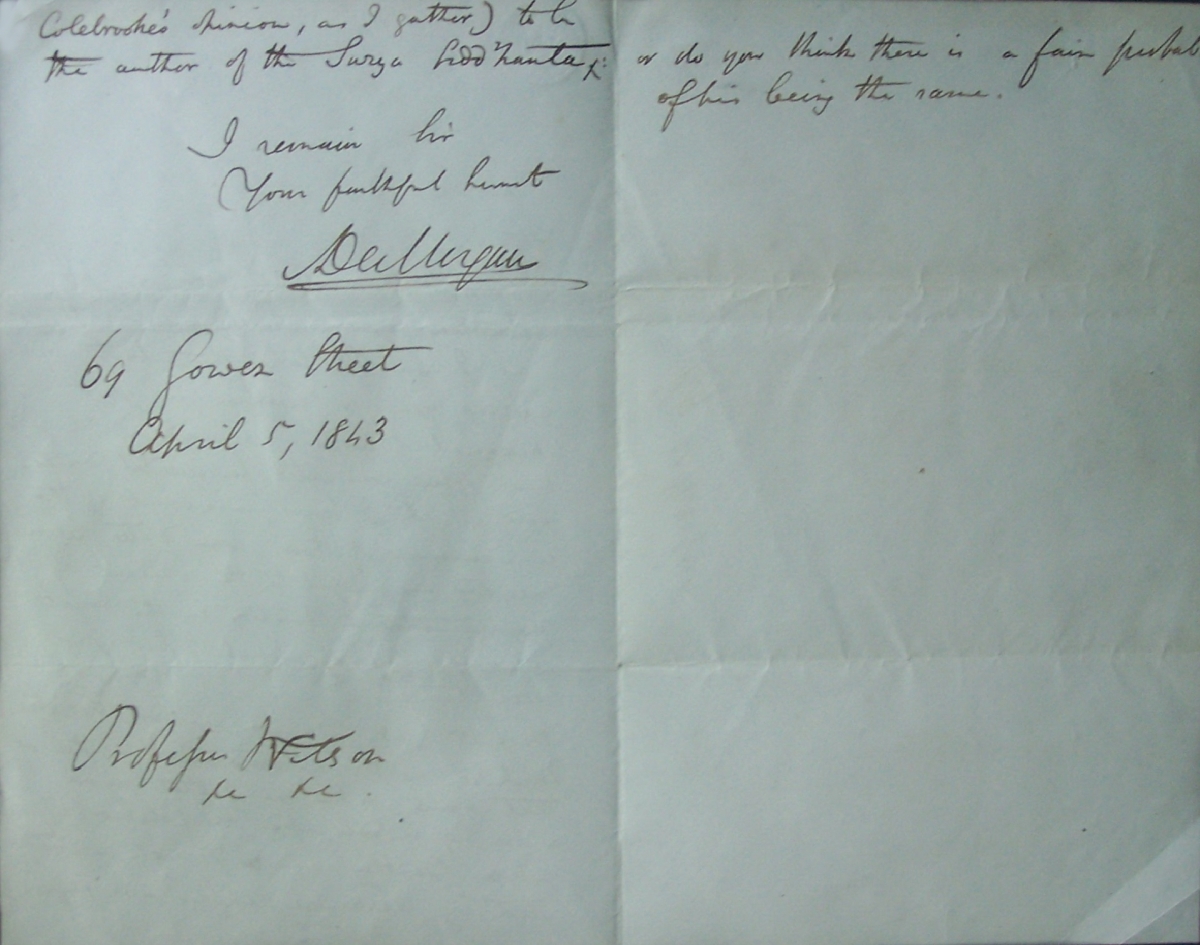- About MAA
- Membership
- MAA Publications
- Periodicals
- Blogs
- MAA Book Series
- MAA Press (an imprint of the AMS)
- MAA Notes
- MAA Reviews
- Mathematical Communication
- Information for Libraries
- Author Resources
- Advertise with MAA
- Meetings
- Competitions
- Programs
- Communities
- MAA Sections
- SIGMAA
- MAA Connect
- Students
- MAA Awards
- Awards Booklets
- Writing Awards
- Teaching Awards
- Service Awards
- Research Awards
- Lecture Awards
- Putnam Competition Individual and Team Winners
- D. E. Shaw Group AMC 8 Awards & Certificates
- Maryam Mirzakhani AMC 10 A Awards & Certificates
- Two Sigma AMC 10 B Awards & Certificates
- Jane Street AMC 12 A Awards & Certificates
- Akamai AMC 12 B Awards & Certificates
- High School Teachers
- News
You are here
Mathematical Treasure: Letter and Visiting Card of Augustus De Morgan
 |
 |
Figure 1. Carte de visite (visiting card) circa 1866 of Augustus De Morgan, signed "ADeMorgan" by him. Photograph by Maull and Polyblank (see Note). (From the collection of Dr. Sid Kolpas)
A Brief Biography
Augustus De Morgan (1806-1871) was one of the most influential and successful teachers of mathematics of the 19th century. Both by contemporary and current standards he was an extraordinary professor. According to Adrian Rice, in the article, “What Makes a Great Mathematics Teacher? The Case of Augustus De Morgan,” he was an example of a great mathematics teacher, one who instilled a love and enthusiasm for the subject in his students, thus having a profound effect on them, even if they never pursued a career in mathematics. Evidence of that opinion comes from the surviving comments of De Morgan’s students, and of some renowned mathematicians who were influenced by his teaching. He possessed that rare combination of insight, humor, and creativity. His lectures were concise and lucid; unlike all too many of his peers, he cared that his students should be stimulated, challenged, inspired, and carefully instructed with sound planning and pedagogy. He hated competitive examinations and the lack of sharing of knowledge that resulted from them (a current problem in our schools); he was in favor of cooperative learning. Students reported that his lectures were rich in humor, applications to other disciplines, references for further study, and love of his subject. Even the most abstract of concepts was made clear through his brilliant use of analogy, metaphor, and simile.
De Morgan was born in Madura, India. He was educated in private schools until his entry to Trinity College, Cambridge, at age sixteen. He was an excellent student, near the top of his class. However, he opted not to obtain the M.A. degree, or to compete for a college fellowship because of his conscientious objection to the religious tests that were required of candidates at Cambridge. In 1828, on the merit of his academic achievement, he received an appointment as professor of mathematics at the newly formed London University (which became University College London). He would teach there for over 30 years, inspiring generations of students. Succeeding generations of his students referred to him as “Gussy” – the tall stout waddling figure peering through gold-rimmed glasses who would passionately teach them mathematics.
His reputation grew because of his outstanding, encouraging, caring teaching and his articles on cutting-edge topics, mathematical puzzles, games, oddities, and paradoxes; De Morgan was the Martin Gardner of the nineteenth century. De Morgan’s love of mathematical puzzles and stories led, posthumously, to the publication of his Budget of Paradoxes (1872); it is still in print. While he was a man of gentle nature, he was also a man of strong conviction. He fought against religious pretense, and was an advocate for women’s educational rights, but was opposed to female suffrage. He also believed that advanced mathematical studies were potentially damaging to a woman's physical health, which was a pervasive attitude toward women at the time. Increasingly liberal as he grew older, he lectured on mathematics to classes of women without charge and encouraged women, even given their presumed mental limitations, to continue with their mathematical studies.
Figure 2. A student's drawing of Augustus De Morgan leading a class at University College London. (This image of MS ADD 7 is used here by kind permission of UCL Library Services, Special Collections.)
De Morgan’s texts were as outstanding as his teaching. Over one hundred years later, they would still be excellent curriculum models. The topics of his texts included algebra, trigonometry, differential and integral calculus, the calculus of variations, probability, and symbolic logic. All of the texts are clear, interesting, and filled with wonderful examples. Among his best publications were An Essay On Probabilities (1838), Calculus (1842), Formal Logic (1847), and Double Algebra (1849), which foreshadowed abstract algebra. When he was not hard at work on his many articles and books—including one-sixth of the articles in the famous Penny Cyclopaedia for which he wrote an article that defined the process of mathematical induction—De Morgan spent time on his two great passions: playing the flute and collecting rare mathematics books. The latter hobby helped him to become the expert of his era on the history of mathematics.
In 1837 Augustus De Morgan married Sophia Elizabeth Frend. Their home, with five children, became the center of a large circle of friends who met there to share intellectual interests. One of Augustus’ friends was George Boole, who along with De Morgan pioneered the development of symbolic logic. De Morgan’s Formal Logic (1847) went to press at the same time as Boole’s work on the algebra of logic. Both works dealt with propositional calculus.
De Morgan perhaps is best remembered for “De Morgan’s Laws,” two related theorems in symbolic logic and set theory, respectively.
Symbolic logic: \[\neg(p\lor q) = \neg p\land\neg q\quad{\rm{and}}\quad\neg(p\land q) = \neg p\lor\neg q\]
Set theory: \[(A\cup B)^{\prime} = A^{\prime}\cap B^{\prime}\quad{\rm{and}}\quad(A\cap B) ^{\prime} = A^{\prime}\cup B^{\prime}.\]
Augustus De Morgan should be remembered, like all inspiring teachers, for the profound influence he had on his students; amongst whom were Isaac Todhunter (1820-1884) and James Joseph Sylvester (1814-1897). He also tutored Ada Lovelace (1815-1852), and encouraged her to develop her mathematical talents; he felt she had superior mathematical talent compared to most women. He was a stimulating force in the development of mathematics and mathematics teachers, a driving force in the development of the logical foundations of mathematics, and a proponent of the modernization of calculus. An unpretentious man, he shunned honorary degrees, membership in the Royal Society, and political and religious pettiness. His life was devoted to his family, his friends, and his students.
Note: Maull & Polyblank's London photographic studio was founded in 1854. The studio specialized in portraits of famous individuals. Their most notable work, Photographic Portraits of Living Celebrities, was published in parts from 1856 to 1859. It consisted of forty individual portraits with biographies, issued to subscribers and then bound into a single volume by the subscriber after all the parts were delivered; this was a practice popular at the time. The portraits were also published as engravings in the Illustrated London News. Return to brief biography of De Morgan.

Figure 3. De Morgan’s An Essay On Probabilities (1838). (From the collection of Dr. Sid Kolpas)
De Morgan’s Algorithm for Approximating Factorials
Factorials of whole numbers play an important role in probability theory, particularly in permutations and combinations. During the 19th century, without calculating devices, these factorials were difficult to compute for large whole numbers. In his Essay on Probabilities, De Morgan introduced the algorithm described in Figure 4, below, to approximate \(n!,\) where \(n\) is a whole number. Note that \([n]\) is De Morgan’s notation for “\(n\) factorial” or \(n!.\) Thus, in the first paragraph in Figure 4, when De Morgan wrote “[a given number],” he meant the factorial of a given positive integer.
 |
 |
Figure 4. De Morgan’s instructions for approximating \(n!\) from pp. 15-16 of his An Essay On Probabilities (Google Books)
Stirling’s approximation of \(n!,\) where \(n\) is a whole number, was discovered by Scottish mathematician James Stirling (1692-1770). Stirling published his most important work, Methodus Differentialis, in 1730. This book discusses infinite series, summation, interpolation, and quadrature. The following formula for \(n!,\) for which Stirling has become known, appears as Example 2 of Proposition 28 of the Methodus Differentialis. Stirling’s approximation states that \[n!\sim\sqrt{2n\pi}\left(\frac{n}{e}\right)^n.\]
De Morgan’s algorithm provided step-by-step instructions for computing the approximation to \(n!\) given by Stirling's Formula.

Figure 5. Title page of Stirling's Methodus Differentialis (Google Books)
Referring to De Morgan’s algorithm for approximating \(n!\) and noting that \(0.4342945\) is an approximation of \(\log_{10} e,\) and \(0.7981799\) is an approximation of \(\log_{10}(2\pi),\) we have:
- Take the base 10 logarithm of the number \(n\), and subtract \(0.4342945\) from it: \(\log n - \log e = \log \left(\frac{n}{e}\right).\)
- Multiply the result by \(n\): \(n\log \left(\frac{n}{e}\right)= \log \left(\frac{n}{e}\right)^n.\)
- To \(\log n\) add \(0.7981799\): \(\log n + \log 2\pi = \log 2n\pi.\)
- Take half of this sum: \({\frac{1}{2}}\log 2n\pi = \log \sqrt{2n\pi}.\)
- Add the results of the 2nd and 4th steps: \[\log \left(\frac{n}{e}\right)^n + \log \sqrt{2n\pi} = \log \sqrt{2n\pi}\left(\frac{n}{e}\right)^n.\]
- Since \(\log n!\sim \log \sqrt{2n\pi}\left(\frac{n}{e}\right)^n,\) then \(n!\sim \sqrt{2n\pi}\left(\frac{n}{e}\right)^n,\) which is Stirling’s Formula.
- This approximation of \(n!\) is a bit too small; to improve it, add \({\frac{1}{12n}}\) of it to itself: \[n!\sim \sqrt{2n\pi}\left(\frac{n}{e}\right)^n + {\frac{1}{12n}}\cdot\sqrt{2n\pi}\left(\frac{n}{e}\right)^n.\]
A Letter of De Morgan Concerning History of Mathematics
As noted above, Augustus De Morgan was a frequent contributor to the Penny Cyclopaedia, contributing over 700 articles to the 27 volumes of the Cyclopaedia, published from 1828 to 1843.

Figure 6. The Penny Cyclopaedia, Volume 26, contains an article by De Morgan about the Indian mathematical text Viga Ganita. (Google Books)
One of De Morgan's last entries in the Penny Cyclopaedia was an article entitled "VIGA GANITA" which appeared on pages 318-326 of Volume 26, published in 1843 (easily accessible via Google Books). De Morgan admitted at the outset of this article that he would discuss much more than just the Viga Ganita (now more often transliterated as Bījagaṇita or Bīja-gaṇita), a work on algebra by the 12th century Indian mathematician and astronomer Bhascara (now generally known as Bhāskara II), who was long believed to have lived and worked at a famous astronomical observatory in Ujjain. Indeed, De Morgan wrote that his plan was to take advantage of the place of the letter “V” near the end of the alphabet to report the very latest scholarship on the “astronomical and arithmetical science of the Hindus” (p. 318). The wait may not have been worth it, because what De Morgan had to write was “an account of the most singular extremes of opinion” (p. 318) – a tale of much disagreement among scholars, at least some of whom he considered to be quite biased.
In this article, De Morgan gave three possibilities for the identity and century of the Indian astronomer and mathematician Varāhamihira, who was of interest to him because (p. 320):
The writers who are most cited by Hindu astronomers bear the names of Varaha-mihira and Brahmegupta.
It is now believed that Varāhamihira lived during the sixth century and Brahmagupta during the seventh century. Both were long thought to have lived and worked in Ujjain at a famed astronomical observatory, as was Bhaskara II centuries later. However, as historian of Indian astronomy and mathematics Kim Plofker reported in her 2009 book, Mathematics in India, there is no evidence that any of the three astronomers lived in Ujjain or that there was even an astronomical observatory there (pp. 318-319, 326).
However, what De Morgan knew in 1843 was that the highly regarded Indologist Henry Thomas Colebrooke and the “astronomers at Ujein” agreed on Varāhamihira's (and Brahmagupta’s) dates, but that others placed Varāhamihira centuries earlier or later ("VIGA GANITA," p. 320):
From his astronomical data, Colebrooke infers that Varaha-mihira wrote at the end of the fifth century, which is also the date assigned to him by the astronomers at Ujein. … There is another Varaha-mihira, whom the same astronomers place in A.D. 200. But popular tradition places Varaha-mihira in the time of Vicramadytia (B.C. 56), and names, as hereafter noticed, several of his contemporaries.
Colebrooke died in 1837. His protégé Horace Hayman Wilson had become the first Boden Professor of Sanskrit at Oxford University in 1832; however, as shown in Figure 7, below, Wilson had written in 1835 that Varāhamihira lived during the first century BCE!

Figure 7. From A Manual of Universal History and Chronology, for the Use of Schools (1835), by H. H. Wilson, page 25, paragraph 43. Here, Wilson placed Varāhamihira at 56 BCE or a little later. Wilson’s “Ougein” became “Ujein” in De Morgan’s article and now is known as Ujjain. (Google Books)
In the following letter from De Morgan to Wilson, De Morgan attempted to confirm Wilson's beliefs about the identity and century of Varāhamihira, probably for his Penny Cyclopaedia article before its publication.


Figure 8. Letter from Augustus De Morgan to H. H. Wilson. Note that De Morgan's signature at the end of the letter is identical to that on the visiting card in Figure 1. (From the collection of Dr. Sid Kolpas)
Transcription of De Morgan’s Letter
Sir
With many apologies for troubling you, wholly unknown to you as I am, I take the liberty of asking you a question on your manual of history [note 1], a work which I have often consulted for oriental dates, and which I have, on account of the convenience of those same dates, recommended as useful to the student of mathematical history in the tract accompanying of which I beg your acceptance.
Page 25 [paragraph] 43 [note 2]. Do you consider Varaha-Mihira [note 3] as the astronomical writer of that name, or the one of that name, whose age is discussed by Colebrooke [note 4], and whom Bentley and a French writer cited by Delambre [note 5] will have (against Colebrook’s opinion, as I gather) to be the author of the Surya Siddhanta [note 6]: or do you think there is a fair probability of his being the same.
I remain Sir
Your faithful Servant
ADeMorgan
69 Gower Street
April 5, 1843
We don not know if De Morgan received an answer from Wilson or, if so, what it was. De Morgan’s reference to “popular tradition” in his article in the Penny Cyclopaedia rather than to Wilson by name may indicate that Wilson backed away from his claim that Varāhamihira lived around 56 BCE.
Notes on De Morgan's Letter and Its Transcription
Note 1. A Manual of Universal History and Chronology, for the Use of Schools. H. H. Wilson, M.A., Boden Professor of Sanscrit, Oxford. London: Whittaker, 1835. Wilson was a protégé of Colebrooke (see Note 4, below) and became the first Boden Professor of Sanskrit at Oxford University in 1832.
Note 2. The passage from A Manual of Universal History and Chronology, for the Use of Schools, by H. H. Wilson, at page 25, paragraph 43, is shown in Figure 7 above.
Note 3. Varāhamihira (505-587) was an Indian astronomer, mathematician, and astrologer.
Note 4. Henry Thomas Colebrooke (1765-1837) was an English Indologist especially interested in religion, linguistics, and astronomy. De Morgan wrote in his Cyclopaedia article, “Mr. Colebrooke was one of the most eminent of Sanscrit scholars, an indefatigable Indian antiquary, and more than well informed in mathematics and astronomy” (p. 319). After spending over 30 years (1783-1814) in India, Colebrooke returned to England where he published Algebra, with Arithmetic and Mensuration, from the Sanscrit of Brahmegupta and Bhascara (London, 1817) and co-founded both the Royal Astronomical Society in 1820 and the Royal Asiatic Society in 1823.
Note 5. John Bentley was an English Indologist of whom De Morgan wrote disparagingly in his “VIGA GANITA” article. Jean Baptiste Joseph Delambre (1749-1822) was a celebrated French astronomer, who also authored books on the history of astronomy from ancient times to the 18th century.
Note 6. The Sūrya-Siddhānta, an astronomy manual that discusses what we call sine, cosine, and tangent, was assumed by some to be one of Varāhamihira’s lesser known works. Plofker (2009) placed the Sūrya-Siddhānta or “Sun-treatise” at about 800 CE, “composed or revised from an earlier work of the same name …. This earlier Sūrya-Siddhānta was partly preserved” in a sixth-century work of Varāhamihira (p. 71).
Return to transcription of De Morgan's letter
References
Augustus De Morgan. A Budget of Paradoxes. London: Longmans, Green and Company, 1872.
Augustus De Morgan. An Essay On Probabilities. London: Longman, Orme, Brown, Green and Longmans, and John Taylor, 1838.
[Augustus De Morgan], "Viga Ganita," Penny Cyclopaedia of the Society for the Diffusion of Useful Knowledge, vol. 26 (1843), pp. 318-326.
Sophia De Morgan. Memoir of Augustus De Morgan. London: Longmans, Green and Company, 1882.
James Essinger. Ada's Algorithm: How Lord Byron's Daughter Ada Lovelace Launched the Digital Age. London: Gibson Square Ltd., 2014.
The J. Paul Getty Museum. “Maull and Polyblank.”
http://www.getty.edu/art/collection/artists/1214/maull-polyblank-british-active-1850s-1860s/
Victor Katz. A History of Mathematics: An Introduction (3rd ed.). Boston: Addison-Wesley, 2009.
New World Encyclopedia contributors, “Henry Thomas Colebrooke,” New World Encyclopedia, last updated 24 February 2009.
http://www.newworldencyclopedia.org/p/index.php?title=Henry_Thomas_Colebrooke&oldid=935378
J. J. O’Connor and E. F. Robertson. “Augustus De Morgan,” MacTutor History of Mathematics Archive, 1996.
http://www-history.mcs.st-and.ac.uk/Biographies/De_Morgan.html
Kim Plofker. Mathematics in India. Princeton: Princeton University Press, 2009.
Adrian Rice. “What Makes a Great Mathematics Teacher? The Case of Augustus De Morgan.” The American Mathematical Monthly. Vol. 106, No. 6 (Jun. - Jul., 1999), pp. 534-552.
Horace Hayman Wilson. A Manual of Universal History and Chronology, for the Use of Schools. London: Whittaker and Co., 1835.
Sidney J. Kolpas (Delaware County Community College), "Mathematical Treasure: Letter and Visiting Card of Augustus De Morgan," Convergence (April 2016)





